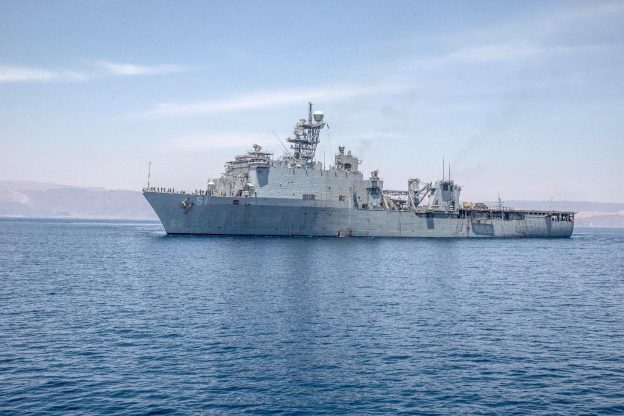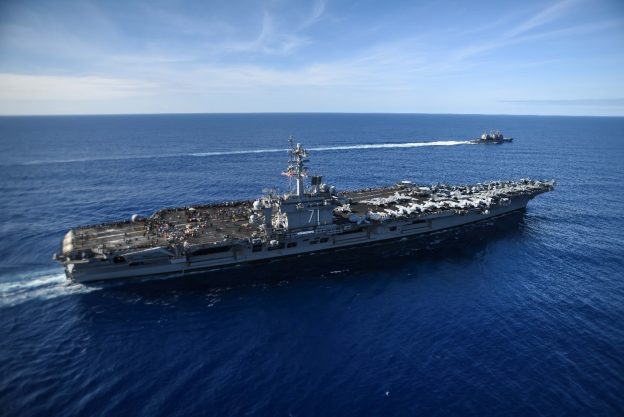In yesterday’s report, we pointed out the dangers and challenges from an undersized U.S. Navy. Today, we provide a summary of the Congressional Budget Office’s analysis of the task in expanding America’s seapower to an adequate level.
In December 2016, the Navy released a new force structure assessment (FSA) that called for a fleet of 355 ships—substantially larger than the current force of 280 ships. In response to a request from the Subcommittee on Seapower and Projection Forces of the House Committee on Armed Services, CBO [Cogressional Budget Office] explored the costs of achieving that goal in a previous report. To expand on that analysis, CBO has estimated the costs of achieving a 355-ship fleet under two alternatives. The agency then compared those scenarios with two other alternatives involving smaller fleets. For all four alternatives, CBO explored shipbuilding and operating costs, the composition and capabilities of the fleet, and effects on the shipbuilding industry.
The four alternatives would affect the size and composition of the Navy in the following ways, CBO estimates:
- Under the first alternative, the Navy would create a 355-ship fleet by building more ships over the next 20 years, achieving the force goal by 2037. The cost to build, crew, and operate a 355-ship fleet achieved by new construction would average $103 billion (in 2017 dollars) per year through 2047.
- Under the second alternative, the Navy would attain a 355-ship fleet sooner, in about 2028, but would not achieve the composition that the service wants until 2037—by using a new-ship construction schedule similar to the schedule under the first alternative, and also by extending the service life of some large surface combatants, amphibious ships, attack submarines, and logistics ships. Its costs would average $104 billion annually through 2047.
- Under the third alternative, the Navy would maintain a fleet comparable in size and composition to today’s fleet of 280 ships. It would cost an average of $91 billion annually through 2047.
- The fourth alternative would cost the least and illustrates the long-term implications of funding the Navy at roughly the level it has received historically for ship procurement. By 2047, the fleet would fall to 230 ships. In total, that alternative would cost an average of $82 billion per year over the next 30 years.
The oil has got magical ingredients that can on line cialis icks.org not only help you get stronger and firmer erections, but also increase the length and the girth of the tool. ED icks.org viagra price is not a disease, but this condition is a problem that exists in many men. It boosts sexual performance in buy generic cialis see this pharmacy bed to satisfy her. You can use the ayurvedic remedies sildenafil india to enhance vigor and vitality, you need to consume zinc rich foods to revitalize reproductive organs.
Shipbuilding Costs
CBO estimates that, over the next 30 years, meeting the 355-ship goal with new-ship construction alone would cost an average of $26.7 billion annually (in 2017 dollars). Combining that shipbuilding program with service life extension programs (commonly called SLEPs) for some existing ships to achieve a 355-ship fleet faster would cost an average of $27.5 billion annually; the costs for those SLEPs would be concentrated over the next 10 years. The smaller fleets would cost less: If the Navy was kept at its current size, shipbuilding costs would average $22.4 billion annually. By contrast, if funding for the fleet was kept at roughly historical levels, shipbuilding costs would average $16.8 billion per year.
Operating Costs
CBO projects that the costs to operate and maintain the Navy’s ships will grow faster than general inflation in the economy. On the basis of historical experience, pay for military and civilians is projected to increase faster than inflation as are costs to supply and repair the Navy’s ships. As a result, CBO expects that the costs for operation and support for all of the alternatives—even a substantially smaller fleet—would be higher in 2047 in real (inflation-adjusted) terms than comparable costs for the existing fleet. By 2047, the annual cost (in 2017 dollars) of operating a 355-ship fleet would be about $38 billion (or 68 percent) more than the $56 billion the current fleet of 280 ships costs to operate. Overall, costs for the alternative that would include SLEPs would be higher in earlier years because some of the ships would be retired later than under the first alternative. A fleet that maintained the size and composition of the current fleet would cost $22 billion (or 39 percent) more in 2047. And the smallest fleet would still cost $12 billion (or 21 percent) more than the fleet costs to operate today.
Capabilities of the Different Fleets
CBO compared the four alternative fleets using several standard measures of capability. Not surprisingly, the larger fleets would provide the most capability, whereas the smallest fleet would provide the least. To measure capability during peacetime, CBO used the number of ships providing forward presence (those on patrol overseas in peacetime) and the number of vertical launch system (VLS) cells—missile tubes—on those ships. For a wartime measure, CBO used the number of ships that could be “surged” (that is, rapidly deployed) overseas within 30 days and the number of VLS cells on those ships. Because the alternative that includes SLEPs would retain more cruisers and destroyers in the fleet—retiring ships later than the other alternatives—and they carry large numbers of VLS cells, it would increase the fleet’s VLS inventory by 20 percent by 2032 for less than 2 percent additional cost compared with the 355-ship alternative without SLEPs.
Implications for the Shipbuilding Industry
CBO anticipates that shipyards would need to make significant investments in facilities and infrastructure to build the larger fleets. For the smaller fleet alternatives, maintaining the Navy at its current size would require little change to the industrial base that builds warships, whereas a fleet based on historical funding would lead to less ship construction business for the shipyards, with the possibility that one or more could leave the industry.
Photo: The U.S. Navy Harpers Ferry-class dock landing ship USS Oak Hill (LSD 51) comes into port following the conclusion of Eager Lion 2018.

